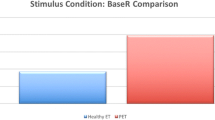Abstract
To explore the origin of clicking sounds in the ear during deglutition or other pharyngeal movements, which are interpreted differently in the literature. Experimental study at a tertiary referral centre. Acoustic phenomena during a forced opening test of the Eustachian tube (ET) were studied in a temporal bone model. Additionally, in vivo experiments were carried out in healthy volunteers for ruling out movements of the ossicular chain or the drumhead as potential causes of clicks. Thus, acoustic recordings were performed parallel to stapedius or tensor reflex measurements or pneumatic video endoscopies of the tympanic membrane. Obviously the acoustic signals (clicks) appear when the tube opens, which could be visualized and acoustically recorded during forced opening tests in temporal bone experiments. Middle ear muscle contractions with movements of the tympanic membrane did not cause any click events. Together with the results of a previous paper (9) we interpret the clicks as disruptions of fluid or mucus films covering the mucosa during the ET opening. The final goal of our studies is to use such clicks as indicators of ET openings in a new tube function test, which has to be elaborated.






Similar content being viewed by others
References
Smith A (1943) Audiometric effects of voluntary contraction of the tensor tympani muscle. Arch Otolaryngol 68:369–372
Badia L, Parikh A, Brookes GB (1994) Management of middle ear myoclonus. J Laryngol Otol 108:380–382
Rock EH (1995) Objective tinnitus and the tensor tympani muscle. Int Tinnitus J. 1:30–37
Pulec JL, Simonton KW (1961) Palatal myoclonus: a report of two cases. Laryngoscope. 71:668–671
Oliveira CA, Jr Negreiros J, Cavalcante IC, Jr Bahmad F, Venosa AR (2003) Palatal and middle-ear myoclonus: a cause for objective tinnitus. Int Tinnitus J. 9:37–41
Slack RW, Soucek SO, Wong K (1986) Sonotubometry in the investigation of objective tinnitus and palatal myoclonus: a demonstration of eustachian tube opening. J Laryngol Otol 100:529–531
Deuschl G, Lohle E, Heinen F, Lucking C (1991) Ear click in palatal tremor: its origin and treatment with botulinum toxin. Neurology 41:1677–1679
Bhimrao SK, Masterson L, Baguley D (2012) Systematic review of management strategies for middle ear myoclonus. Otolaryngol Head Neck Surg 146:698–706
Ehrt K, Fischer HG, Rüdiger D, Punke C, Ovari A, Pau HW (2016) “Physiological” ear clicking—its origin and potential usability as a test tool for the Eustachian tube function. Otol Neurotol 37:345–349
Klockhoff I, Anderson H (1960) Reflex activity in the tensor tympani muscle recorded in man; preliminary report. Acta Otolaryngol 51:184–188
Pau HW, Strenger T (2010) An easy method for fitting conventional endoscopes for pneumatic video otoscopy. Laryngoscope. 120:1350–1353
Fischer HG, Koch A, Kähler W, Pohl M, Pau HW, Zehlicke T (2016) The measurement of Eustachian tube function in a hyperbaric chamber using an ear canal microphone. Diving Hyperb Med 46:33–37
Pahnke J (2000) Morphology, function, and clinic of the Eustachian tube. Laryngo-Rhino-Otol 79(S2):S1–S21
Author information
Authors and Affiliations
Corresponding author
Ethics declarations
The study involves human participants, in whom informed content was obtained.
Conflict of interest
Disclosure of potential conflicts of interest: None of the authors has any conflicts of interest.
Ethical approval
All procedures performed in studies involving human participants were in accordance with the ethical standards of the institutional and/or national research committee and with the 1964 Helsinki declaration and its later amendments or comparable ethical standards.
Rights and permissions
About this article
Cite this article
Pau, H.W., Ehrt, K., Fischer, HG. et al. On the origin of ear clicks during deglutition or pressure equalization. Eur Arch Otorhinolaryngol 273, 4267–4271 (2016). https://doi.org/10.1007/s00405-016-4178-z
Received:
Accepted:
Published:
Issue Date:
DOI: https://doi.org/10.1007/s00405-016-4178-z




